

Category theory « The Unapologetic Mathematician. Comma Categories Another useful example of a category is a comma category.

The term comes from the original notation which has since fallen out of favor because, as Saunders MacLane put it, “the comma is already overworked”. We start with three categories. CDGuide. Mathematicians have been using diagrams of objects and arrows to explain their work since at least 1945.1 Conventionally, these are called commutative diagrams (even when they don't commute2).
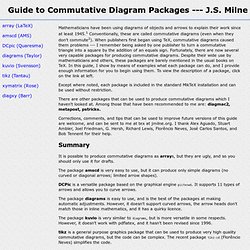
When publishers first began using TeX, commutative diagrams caused them problems --- I remember being asked by one publisher to turn a commutative triangle into a square by the addition of an equals sign. Fortunately, there are now several very capable packages for producing commutative diagrams. Despite their wide use by mathematicians and others, these packages are barely mentioned in the usual books on TeX.
In this guide, I show by means of examples what each package can do, and I provide enough information for you to begin using them. To view the description of a package, click on the link at left. Except where noted, each package is included in the standard MikTeX installation and can be used without restriction. Summary DCPic is a versatile package based on the graphical engine pictexwd. Physics, Topology, Logic and Computation: a Rosetta Stone. Coherence theorem. In mathematics and particularly category theory, a coherence theorem is a tool for proving a coherence condition.
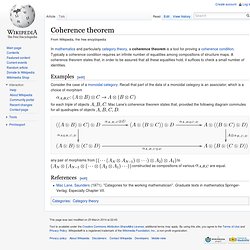
Typically a coherence condition requires an infinite number of equalities among compositions of structure maps. The n. Homotopy Type Theory, I. Vladimir Voevodsky. Type theory in nLab. Intuitionistic type theory. Intuitionistic type theory (also known as constructive type theory, or Martin-Löf type theory) is a type theory and an alternative foundation of mathematics based on the principles of mathematical constructivism.
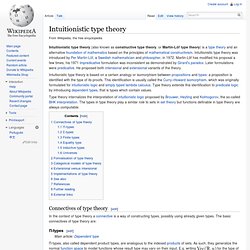
Intuitionistic type theory was introduced by Per Martin-Löf, a Swedish mathematician and philosopher, in 1972. Martin-Löf has modified his proposal a few times; his 1971 impredicative formulation was inconsistent as demonstrated by Girard's paradox. Later formulations were predicative. Topology. General Topology is based solely on set theory and concerns itself with structures of sets.

It is at its core a generalization of the concept of distance, though this will not be immediately apparent for the novice student. Topology generalizes many distance-related concepts, such as continuity, compactness, and convergence. Before You Begin[edit] In order to make things easier for you as a reader, as well as for the writers, you will be expected to be familiar with a few topics before beginning. Motivation and Preliminaries[edit] Chapter 1.1 IntroductionChapter 1.2 HistoryChapter 1.3 Basic Concepts Set Theory (Apr 13, 2013) General Topology[edit] Introduction to Topology[edit] Properties of Topological Spaces[edit] Vector Spaces[edit] Algebraic Topology[edit] Homotopy[edit] Topology/Homotopy. Algebraic topology is the branch of topology where algebraic methods are used to solve topological problems.
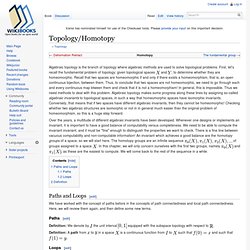
First, let's recall the fundamental problem of topology; given topological spaces and , to determine whether they are homeomorphic. Recall that two spaces are homeomorphic if and only if there exists a homeomorphism, that is, an open continuous bijection, between them. nLab. Groupoidification. John Baez November 20, 2009 Groupoidification is a form of categorification where we do linear algebra with groupoids instead of vector spaces.
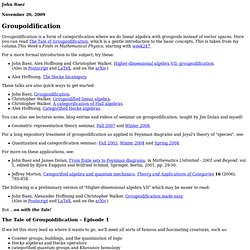
Here you can read The Tale of Groupoidification, which is a gentle introduction to the basic concepts. This is taken from my column This Week's Finds in Mathematical Physics, starting with week247. For a more formal introduction to the subject, try these: These talks are also quick ways to get started: You can also see lectures notes, blog entries and videos of seminar on groupoidification, taught by Jim Dolan and myself: Geometric representation theory seminar, Fall 2007 and Winter 2008. The Tale of Groupoidification – Episode 1 If we let this story lead us where it wants to go, we'll meet all sorts of famous and fascinating creatures, such as: However, the charm of the tale is how many of these ideas are unified and made simpler thanks to a big, simple idea: groupoidification.
So, what's groupoidification? Which "makes sure the cat is dead": The nauty page. Brendan McKay and Adolfo Piperno Please visit the new nauty Traces page at for much more than is here.
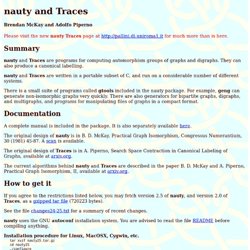
Summary nauty and Traces are programs for computing automorphism groups of graphs and digraphs. They can also produce a canonical labelling. nauty and Traces are written in a portable subset of C, and run on a considerable number of different systems. There is a small suite of programs called gtools included in the nauty package. Documentation A complete manual is included in the package. The original design of nauty is in B. The original design of Traces is in A. The current algorithms behind nauty and Traces are described in the paper B. How to get it If you agree to the restrictions listed below, you may fetch version 2.5 of nauty , and version 2.0 of Traces , as a gzipped tar file (720223 bytes). See the file changes24-25.txt for a summary of recent changes. nauty uses the GNU autoconf installation system. Category Theory Awodey Course.